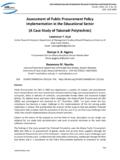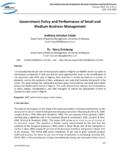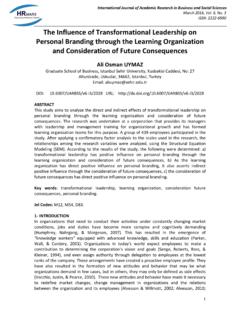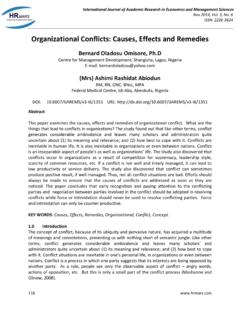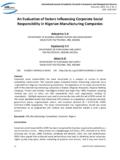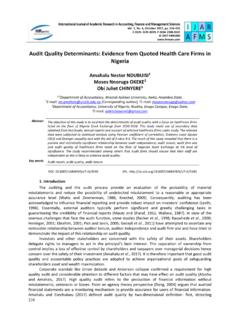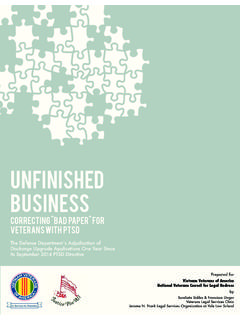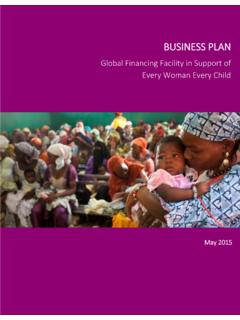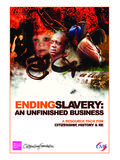Transcription of An Unfinished Agenda: Why is the Boy Child Endangered?
1 International Journal of Academic Research in business and Social Sciences April 2012, Vol. 2, No. 4 ISSN: 2222-6990 181 An Unfinished agenda : why is the Boy Child Endangered? John Koskey Chang ach Moi University, School of Education, Educational Foundations Department Email: Abstract Persistent campaign for awareness of girl s retention in school has started bearing fruits, but in retrospect the society has ignored the plight of boy- Child . The issue of the Boy- Child has not been adequately addressed (World Bank, 2005). Extensive analysis of data indicates that boy- Child is at a higher risk of dropping out of school than girls. The trend of more boys dropping out of school started in a cohort comprising of 620,000 boys and 586,000 girls that joined standard one in 2005.
2 By 2010, survival rate in the group had dropped to 558,000 boys and 562,000 girls. Never before had enrolment of girls in any primary school grade nationally had exceeded that of boys (UNESCO, 2003).This impedes the achievement of Universal Primary Education which is Millennium Development Goal, number two that by 2015 ensure that all boys and girls alike complete primary schooling. This paper seeks to examine the problems that hinder the boy Child from achieving their dream as revealed in the transition rates from primary to secondary schools in Keiyo South district, Elgeyo-Marakwet County. It identifies the challenges to the achievement of education for all and proposes positive actions for the mitigation of the situation. Key words: Boy- Child , Challenges, Unfinished agenda , Transition Introduction The boy Child of the 21st Century is faced with tremendous challenges which unless properly guarded, the society is losing him.
3 All children are future leaders of tomorrow and guardians of the future, and the first aim of every family and society should be to raise healthy and productive individuals who are physically, psychologically, society and mentally well developed. These can be achieved through guidance and the education of the boy- Child who is the father of tomorrow. The negligence of issues affecting the boy- Child is apparent and evident in most discourse and academic literature. Access to education lies at the heart of development. Lack of educational access and securely acquired knowledge and skills is both a part of the definition of poverty and a means for diminution. Quality education is influenced by several factors which include access to education, retention rates, dropout rates and adequacy of instructional resources (World Bank, 2005).
4 The lack of access to secondary education is increasingly seen to constrain countries abilities to pursue effective growth and development strategies which is leading governments International Journal of Academic Research in business and Social Sciences April 2012, Vol. 2, No. 4 ISSN: 2222-6990 182 and the funding community to place increased emphasis on the expansion of secondary education (World Bank, 2005). International reports such as Education For All global monitoring report (UNESCO, 2003), indicates that at the national level, Kenya has virtually attained gender parity in enrolment at both primary and secondary education levels. However, close scrutiny reveals that serious gender disparities in enrolment exist between regions as regards access, retention, completion, performance and transition.
5 Despite the introduction of Free Primary Education and other interventions, transition rates are still very low (Republic of Kenya, 2007). Republic of Kenya (2005), report indicates transition rates for both boys and girls from primary to secondary education has been identified by international community as a key measure towards education access for all. Additionally, Sessional Paper no. 1 of 2005 notes that there are low rates in secondary sub-sector as a result of poor transition from primary to secondary. Education Production Function attempts to relate input and output in education sector. Education is viewed as an investment which utilizes resources from individuals and society and is expected to yield output. In Keiyo South district, the enrolment and retention in both primary and secondary for both boys and girls are still very low as indicated in Table Table KCPE Registered Candidates for the Years 2000-2009 S/NO YEAR BOYS GIRLS TOTAL 1 2000 1819 1933 3752 2 2001 2216 2216 4332 3 2002 2220 2274 4494 4 2003 2273 2427 4700 5 2004 2424 2523 4947 6 2005 2521 2749 5270 7 2006 2486 2646 5132 8 2007 2807 2868 5675 9 2008 2663 2943 5506 10 2009 2640 2790 5431 Source: DEO S Office, Keiyo South (2011) It can be noted that over a period of time, the number of boys has been lower compared to that of girls which in turn influences the transition rates.
6 International Journal of Academic Research in business and Social Sciences April 2012, Vol. 2, No. 4 ISSN: 2222-6990 183 KCPE Registered Candidates YEAR BOYS GIRLS TOTAL 2009 1530 1611 3141 2010 1549 1612 3161 Source: DEO S Office, Keiyo South (2011) The figures indicate that the number of boys who registered for the KCPE examination was smaller compared to girls for the two years. Table KCSE Registered Candidates YEAR BOYS GIRLS TOTAL 2009 550 784 1334 2010 562 867 1631 Source: DEO S Office, Keiyo South (2011) The figures indicate clearly that the number of boys who registered for KCSE examinations was smaller to girls for the two years. It is important to note that in a country such as Kenya where the girl Child is given prevalence, leaves the boy Child vulnerable in the foreseeable future.
7 Equally of concern as regards to transition rates from primary to secondary education, so much attention and emphasis has been given to the girl Child and thus ignoring the issues of the boy Child . It is in response to the unfolding discrepancies that this paper focuses on the boy Child and in specific factors affecting transition rates from primary to secondary school. Who is a Boy- Child ? It is paramount to define what is meant by boy Child so that we start on common ground. Various policies, Acts and statutes define children differently. African Charter on the Rights of the Child defines a Child as everyone below the age of 18. In this paper, boy- Child is defined as a male offspring below the age of eighteen years. Gender equity refers to the practice of fairness and justice in the distribution of benefits, access and control of resources, responsibilities, power, opportunities and services.
8 It is specifically the elimination of all forms of discriminations based on gender (Republic of Kenya, 2007). What is the Problem? In Africa, for example, children are often needed to work on the family land and the loss of their labour is a cost to their parents, even if paid employment in the modern sector is not available. This propels parents not to educate their children especially the boy- Child so that International Journal of Academic Research in business and Social Sciences April 2012, Vol. 2, No. 4 ISSN: 2222-6990 184 they work for the family. Boy- Child often engages in manual jobs, does not attend schooling and exploited as result of Child labour. Empirical studies contend that more emphasis should be placed on girl- Child education in many countries (EFA, 2000). This had led to back grounding of boy- Child thus detrimental.
9 According to the EFA (2000) continuous lobbying and advocacy, and training to mainstream gender equity in the entire education system will have to be intensified. Development of realistic gender sensitive benchmarks and indicators is a critical variable in achieving EFA goals. Targeting of the girl- Child , and in some instances the boy- Child , is necessary if not essential for EFA. This has led the boy Child to be relegated at the periphery and thus endangered. Childhood Sexual Abuse (CSA) is a worldwide problem. Although most studies on the long-term consequences of CSA have focused on women, sexual abuse of both boys and girls is common (Dube, 2005). The Role of Boy- Child in Kalenjin Society Among some Kalenjin Communities, the boys education is sacrificed for the sake of livestock herding and labour.
10 Among the Kalenjin boys are taught to be masculine. This takes place in the various institutions of society such as the family, school and church. Implicit in such education are beliefs that the boy Child is stronger, more intelligent and more powerful than girl- Child , and therefore does not need protection as girl Child . He is not expected to express his emotions or any weaknesses. For example, he is taught not to cry but always behave in a brave manner since boy Child is socialized not to display their weakness; they tend to suffer in silence. These dynamics have not only contributed to the neglect of issues that affect the boy Child among the Kalenjin. Society teaches males that they must be in control all the times. Therefore males tend to dominate in many aspect of life. The confounding power, control and domination imply that males do not have problems.
